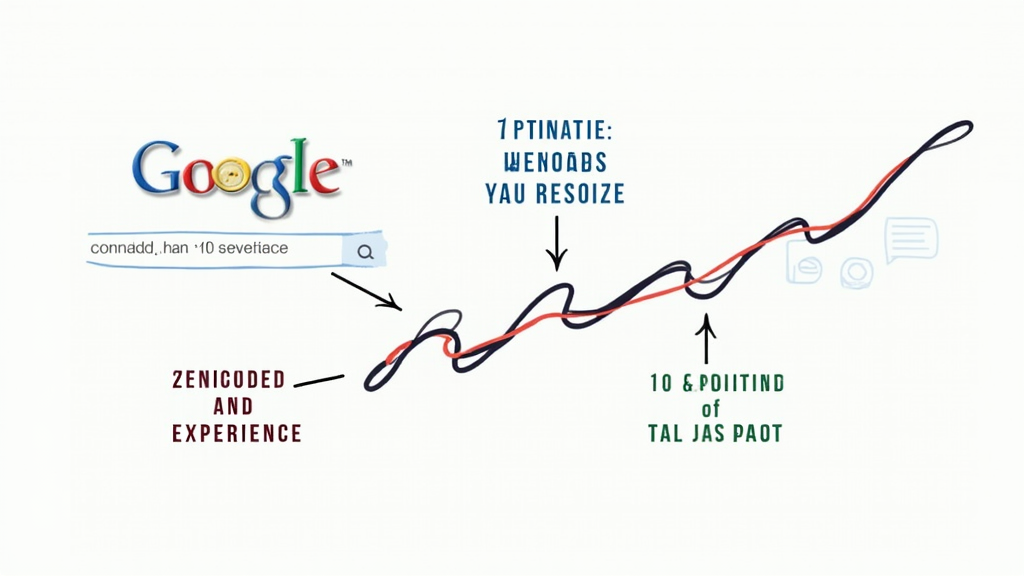Your website isn’t ranking on Google, and you’re scratching your head, wondering why. It’s a common issue, and you’re not alone. Businesses and individuals rely on Google rankings to drive traffic, generate leads, and create conversions. But cracking the code of how Google ranks websites can feel like deciphering a cryptic language. Whether you’re a small business owner, a budding blogger, or a marketing enthusiast, understanding these ranking factors is essential to achieving the visibility you’re aiming for. Recognizing where you might be going wrong and how to set things right is the first step toward climbing those rankings.

Why am I blogging about Website Ranking?
Online visibility in today’s digital age is crucial. For businesses, it leads to increased sales. For individuals, it means reaching more readers or followers. Although millions of people search every day, less than 25% scroll past the first page. This makes being in the top search results more important than ever. Understanding how to improve your Google ranking can transform how effectively you achieve your goals through your website.
The world of SEO (Search Engine Optimization) is constantly evolving, making it challenging to keep up with the latest trends. Every few months, Google updates its algorithms, shifting the landscape and requiring businesses to adapt their strategies continuously. Trends like mobile-first indexing, voice search optimization, and user experience have emerged, becoming critical components of ranking factors. The dynamic nature of these changes makes staying informed not just helpful; it’s necessary to maintain or improve your ranking.
Statistics underline the significance of search engine rankings. A study from Backlinko found that the top Google search result has a 31.7% click-through rate, which is ten times higher than a page 10 result. Companies with the highest rank on Google capture a much larger audience and, therefore, have a huge advantage over their competitors. Such insights highlight the importance of boosting your ranking to tap into a larger market share.
Years ago, Google’s ranking algorithms were relatively simple. Websites that engaged in unethical practices like keyword stuffing and link farming could manipulate results and climb to the top. Over time, Google developed more sophisticated algorithms to reward high-quality content that meets the user’s intent. Back in 2011, the Panda algorithm update marked a significant milestone, penalizing websites with thin content. Google continues to evolve, focusing more on secure, fast-loading sites equipped for mobile users today. Understanding this evolution is crucial, as it informs the strategies you apply to enhance your site’s ranking.
Getting Started with Improving Your Google Ranking
Tackling the challenge of improving your ranking might seem daunting, but breaking it down into manageable steps helps. Start with the basics: SEO. This encompasses a variety of tactics designed to make your website more attractive to search engines. Prioritizing high-quality content, selecting relevant keywords, and improving user experience are key components.
Beginners should know that patience is key. SEO is a long-term investment that doesn’t always show immediate results. However, every effort you put into it compounds over time. Focus on creating content that provides real value to your audience, and remain consistent in your approach.
- On-Page SEO: This involves optimizing individual pages to earn more relevant traffic. It includes actions like optimizing title tags, using meta descriptions, and ensuring your content is clear and accessible.
- Off-Page SEO: This term refers to all activities that happen outside your website to raise its rank. Link-building is a significant off-page SEO factor, providing your site with valuable backlinks from authority domains.
- Technical SEO: The behind-the-scenes builds of your site. This includes mobile-friendliness, page speed, and crawlability to improve search visibility.
Here Are a Few Steps to Help
To boost your website’s rankings, implement these steps strategically. Each step builds on the previous one, so they work together effectively to help you reach your goals.
- Conduct a Site Audit: Start by analyzing your current situation. Tools like Google Analytics and Search Console can help you understand where you stand and identify opportunities for improvement.
- Keyword Research: Determine which keywords your target audience is searching for. Use tools like SEMrush or Ahrefs to find high-volume, low-competition keywords that you can realistically rank for.
- Optimize Your Content: Ensure all your content is valuable, keyword-rich, and answers direct questions. Update old posts and refine your existing content for better engagement.
- Improve User Experience: Make your site easy to navigate, with quick loading times and clear, engaging content. This invites users to stay longer, reducing bounce rates.
- Build Quality Backlinks: Establish your site as an authority through backlinks from reputable sources. Guest blogging and collaborating with other sites can help.
These steps, implemented consistently, lead to tangible improvements in your site’s rankings. Be sure to monitor progress regularly and tweak strategies as needed.
Common Challenges and How to Overcome Them
Getting your website to rank high on Google can be riddled with challenges. It’s important to know what they are and how to tackle them.
- Technical SEO Issues: Addressing site problems such as broken links or slow load times is crucial.
- Quality Backlink Deficit: Building authoritative links to your site can boost its trustworthiness.
- Content Quality and Engagement: Keep your content relevant and engaging to prevent high bounce rates.
- Algorithm Changes: Staying updated with Google’s algorithm helps adapt strategies accordingly.
Technical SEO Issues
Technical SEO can easily fall by the wayside due to its complex nature. Problems like broken links, slow load times, and mobile unfriendliness can hinder your ranking. It’s often helpful to conduct regular technical audits to uncover and fix these issues. Ensuring a seamless user experience by fixing these technical glitches is vital for boosting site confidence and improving your ranking.
Quality Backlink Deficit
Lacking high-quality backlinks can be another obstacle. Google considers backlinks as votes of confidence in your site. Without them, your site may appear less trustworthy, hindering its ability to rank well. Start a link-building campaign, whether through outreach, guest blogging, or broken link building, to slowly accumulate strong backlinks over time.
Content Quality and Engagement
Quality content is the backbone of a good ranking. However, if your content isn’t engaging, you might notice visitors bouncing off your site quickly, sending negative signals to search engines. Focus on crafting content that answers questions, solves problems, and keeps readers interested to lower bounce rates and enhance user satisfaction.
Algorithm Changes
Algorithm changes can disrupt rankings. Suddenly, strategies that worked well may become obsolete. Thus, keeping up with these updates allows you to adapt and optimize your content and strategies efficiently. Subscribe to SEO blogs and online forums to gain insights and updates on the latest changes and trends.
—
Remember, these challenges are part of the journey. With determination and a learning mindset, you can overcome them and see improved results.
Advanced Tips and Tricks
Once you have the basics down, taking your SEO game to the next level with advanced strategies is beneficial. These tactics can really make your approach more effective and distinct.
Schema Markup: Adding schema markup makes your content more understandable to search engines, allowing it to get featured in rich snippets.
Why This Tip is Key: It enhances visibility and can boost click-through rates significantly.
Voice Search Optimization: Optimizing for voice search changes how you consider keywords, focusing more on conversational language.
Why This Tip is Key: With the rise of digital assistants, this can reach a broader, evolving audience.
User Intent: Pay attention to what users are looking for beyond keywords. Creating content that answers specific queries or fulfills users’ needs improves ranking.
Why This Tip is Key: Aligning with user intent helps increase engagement and satisfaction.
Leveraging these advanced tips can position your content to not only appear in search results but to stand out as well. Understanding the importance of these strategies will ensure your site does more than just survive — it thrives.
Why Improving Google Ranking Matters?
Improving your Google ranking is not just about visibility; it impacts several aspects of a business’s online presence. Better ranking means increased traffic, which can lead to more engagements and conversions. Whether you’re selling products, sharing valuable content, or promoting an idea, being on the first page can greatly amplify your message.
Consider a local coffee shop that optimized its website for local searches. After implementing SEO strategies, its online presence improved significantly, leading to more foot traffic. Another example is a blogger who consistently posts SEO-optimized content. Over time, they saw a steady increase in readers and engaged community members.
In Summary:
- Local Business: Visibility led to increased customer trust and foot traffic.
- Blogger: Boosted readers due to consistently optimized content.
- Technology Start-up: Attracted potential investors through compelling SEO strategies.
These examples show that improving your Google ranking can open up vast opportunities. Efforts to improve your ranking align well with goals like brand awareness, community engagement, and direct sales growth.
Comparison of Tools or Approaches
To enhance your SEO strategies, it’s very useful to compare tools and methods. Each has unique features that may cater to different needs and preferences.
- Google Analytics: Comprehensive insights into user behavior but requires time to master fully.
- Yoast SEO Plugin: Perfect for beginners to get started with on-page SEO effortlessly, though it might lack advanced functionalities.
- SEMrush: Offers a suite of tools for serious SEO professionals, although it can be pricey for those just beginning.
Choosing the best tool or approach largely depends on your specific needs. Beginners may find Yoast suitable, while more advanced SEOs might opt for SEMrush. Google Analytics, though a bit technical, is essential for anyone wanting a deeper understanding of their audience.
Frequently Asked Questions
Question: How long does it take to see results from SEO efforts?
Answer: Generally, you can expect to see results from SEO efforts within six months, but this varies depending on the competition and the current state of your website.
Question: Do social media signals affect Google ranking?
Answer: Social media indirectly influences ranking by increasing content visibility, which can lead to more backlinks and traffic.
Question : What is keyword stuffing, and why is it harmful?
Answer: Keyword stuffing is overusing keywords on a page to manipulate ranking. This can harm user experience and result in penalties from search engines.
Is Improving Google Ranking Right For You?
As online presence continues to gain importance, improving Google ranking becomes a worthwhile investment for anyone with a website. Predictions hint at a future where algorithmic efficiency grows, demanding more nuanced and refined strategies. With this evolving landscape, businesses of all sizes can benefit from enhanced online visibility.
Anyone from small entrepreneurs to large enterprises who want to leverage online channels for growth should consider improving their Google ranking as a pivotal part of their marketing strategy. It’s an ongoing process that pays dividends in increasing brand awareness and driving traffic over time.
To stay ahead, keep learning and experimenting with new strategies. The digital world evolves quickly, and staying informed helps ensure your site remains competitive and effective.
Conclusion
Navigating the world of SEO and Google rankings can be challenging, but it’s a rewarding journey. We’ve discussed why it’s essential, how you can start, the steps to take, common challenges, and advanced tips to enhance your site’s ranking. Embrace the process, and remember, the goal is not just to keep up with algorithm changes but to meet and anticipate user needs. Stay committed, and you’ll see the difference in your site’s performance and visibility.
Start your journey today, and don’t forget to share your experiences or questions in the comments below!
